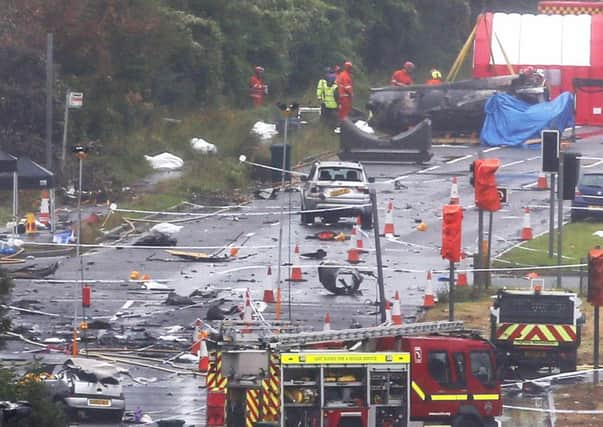Camera suggests no fault with Shoreham disaster jet


The interim report by the Air Accidents Investigation Branch (AAIB) also noted that the video showed the 1950s Hawker Hunter jet “appeared to be responding to the pilot’s control inputs”.
Eleven people died when the plane plummeted on to the A27 in West Sussex during the Shoreham Airshow on 22 August.
Advertisement
Hide AdAdvertisement
Hide AdThe jet failed to pull out of a loop-the-loop stunt before crashing on to the road, exploding into a fireball.
The pilot, Andrew Hill, was left fighting for his life and has been moved to a specialist hospital for treatment.
The AAIB said the plane went into the manoeuvre at 200 feet.
David Learmount, a former pilot and RAF flying instructor, claimed the crash would not have happened if the plane had started at a higher altitude.
He said: “When you go into a vertical manoeuvre you tend to go out of it in the same height you go in, but it’s easy to come out of it slightly lower - you don’t have to take much of a misjudgment to do that.
“If you go into it low you have reduced the room for error.” Mr Learmount, who is consulting editor of Flightglobal online magazine, added: “If he had been 500 feet when he entered the manoeuvre and done exactly the same thing, 11 people would be alive today.”
The AAIB found that the pilot and his seat were thrown from the cockpit as the plane hit the ground. The investigation has not yet determined whether this was caused by an attempted ejection or the impact of the crash.
According to the interim report, the Hawker Hunter was not fitted with a flight recorder but there were two “image recording cameras” mounted within the cockpit.
Advertisement
Hide AdAdvertisement
Hide AdOne was located between the two seats, giving a partial view of the pilot and instrument panel, as well as a view through the cockpit canopy and windscreen.
The report stated: “To date no abnormal indications have been identified.
“Throughout the flight, the aircraft appeared to be responding to the pilot’s control inputs.”
The other camera was mounted at the base of the windscreen looking over the nose.
The preliminary report noted that investigators have received a “large amount” of video and photographs of the aircraft from various locations around Shoreham Airport, where the airshow was taking place.
Many of these are in high definition and will be analysed in a bid to determine the parameters of the jet’s manoeuvres, including flight path and speed.
The AAIB said the pilot carried out a pre-flight inspection before taking off from North Weald Airfield, Essex, to fly to Shoreham and there were “no reported defects”.
The document added: “The pilot was described as being in good spirits and looking forward to the flight.”
Most of the aircraft wreckage has been recovered and sent to the AAIB’s headquarters in Farnborough, Hampshire. Work continues to locate some small pieces of the plane.